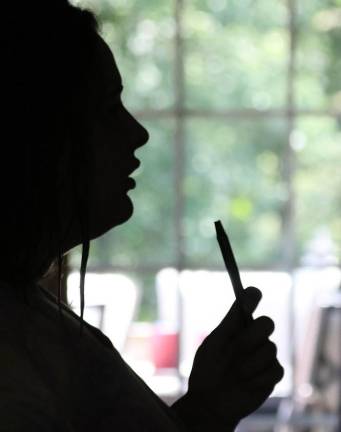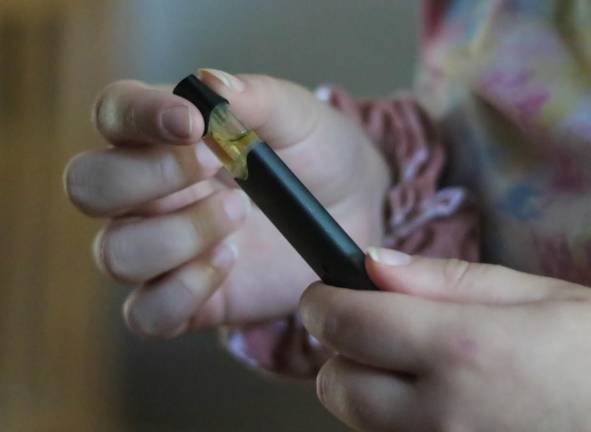Vaping detectors coming to Sparta High School
SPARTA. Among area educators, reaction to the new vaping detection technology is mixed, with some hopeful that it can help bring down “alarming rates” of teen vaping, and others disappointed by recent experiences.


By Nicole M. Wells
As students wind down their summer vacations and reluctantly check school supply lists for the coming year, Sparta Public Schools Superintendent Michael Rossi recently did a little back-to-school shopping of his own.
Instead of a new graphing calculator or the latest tablet, Rossi picked up two HALO IOT Smart Sensor vape detection devices, which will be installed at the high school around the beginning of the school year, he said.
The exact location of the devices cannot be revealed, Rossi said, however, he said that they are easy to set up and will be moved throughout the school periodically.
Vaping, which is inhaling and exhaling aerosol or vapor produced by an e-cigarette or similar device, has reached “alarming rates" among teens, Rossi said.
According to Center on Addiction, the vapor particles contain varying amounts of toxic chemicals, which have been linked to cancer, as well as respiratory and heart disease.
Center on Addiction is the nation’s leading science-based nonprofit organization dedicated to transforming how the nation addresses addiction, according to the organization’s web site.
Because the vapor particles do not linger in the air the way smoke does, vaping is much more difficult to detect than cigarette smoking, Rossi said.
“When you get into a car, and someone was just smoking a cigarette, even though it was an hour ago, you can smell it,” he said. “When you vape, you walk into a car, and it’s gone within a few moments.”
According to manufacturer IPVideo Corporation, the HALO IOT Smart Sensor is equipped with 11 sensors and is capable of detecting vape, smoke, carbon dioxide, carbon monoxide, ammonia, benzene, formaldehyde, trichloroethylene, xylene, mold and other fungi, particulate matter and tetrahydrocannabinol (THC).
Although the district is trying HALO detectors initially, Rossi said it will probably try multiple brands to determine what works best.
“Like most everything else that we do, it seemed like a prudent course of action to test drive before we make a larger investment,” he said, of the decision to purchase two initial sensors. “Our goal is to have our decision by the time that we are ready to build our 2020-2021 budget.”
Rossi stressed that the purpose of installing vape detectors is deterrence.
“If it means that we become more aware of student usage, we will respond to it and handle it,” he said. “But right now we don’t have any deterrents.”
Regarding privacy concerns, Rossi said that student safety is of the utmost importance and that the district sought legal advice about installing the sensors.
“There’s no cameras and you’re not allowed to smoke in school, so I don’t have concerns about invasion of privacy when students are at risk of hurting themselves,” he said. “We’ve already been in contact with counsel about it, and we very well might get challenged on it.”
The HALO IOT Smart Sensor was designed to maintain privacy, according to the company’s web site. Bathrooms and locker rooms are two places the device was intended to be installed.
Still, Rossi said he recognizes that there's a fine line between safety and privacy.
“If somebody’s going to say that their privacy was invaded because they were doing something illegal and harmful to themselves or others ... I think our case is strong,” Rossi said. “My job is to keep kids safe and protect their privacy, so we’re sensitive to that.”
Douglas Reynolds, assistant principal of Student Affairs at Lenape Valley Regional High School in Stanhope, said his district piloted two FlySense vape sensor devices from Soter Technologies last year, to disappointing results.
Billed as “the leader in real-time vape detection” on its web site, the company counts 29,157 vaping incidents FlySense devices have detected since January 2019.
“The concept was really good,” Reynolds said. “The idea was when the vape sensor picked up the vape, it would send an alert to any (staff member) who had the app on their phone.”
Unfortunately, he said, that wasn’t exactly how it worked out for much of the time the district had the devices.
“There were a lot of false positives,” Reynolds said. “It picks up everything, from air fresheners to perfume.”
Apart from failing to detect the correct substances, the main problem, Reynolds said, was that the alerts weren’t in real time. By the time an alert went out and staff responded to the location, nobody was there.
“We were using a lot of resources reacting to these false positives,” he said.
In an attempt to make the devices work better, the school worked with the company as a partner, Reynolds said, but it ultimately declined to adopt them permanently.
“In the end, we decided that it wasn’t a good fit for us,” he said. “We said, ‘Come back when you work these bugs out.’”
The functionality the district most wanted to see in an updated release of the product was a history function, Reynolds said.
The company did end up circling back to them, and the district asked if the history function it wanted to see had been incorporated.
Reynolds said it hadn’t.
In the absence of a high tech solution to the problem of student vaping, the district tried a different approach.
“One of the most effective things that we did last year to stop the vaping was we brought in an excellent speaker,” Reynolds said. “His name was Tim Shoemaker and he brought to light a lot of information for the kids that they didn’t realize about the dangers of vaping.”
Shoemaker’s presentation pointed out the health risks of the chemicals present in vaping solutions and the deceptive marketing that vape manufacturers use to sell their products, Reynolds said.
In addition to talking to the students, Shoemaker also gave a presentation to the parents and teachers.
“He also did a phenomenal teacher in-service, and he showed us all the new stuff that the kids hide the vapes in and what to look for,” Reynolds said. “He was showing us false bottoms on water bottles and hairbrushes and clothing that kids have that’s specially designed to hide stuff like that.”
Shoemaker was well received by not just the adults, but also by the students, Reynolds said.
“We got a lot of great feedback from the kids,” he said. “We actually dramatically decreased the number of times we caught kids vaping after the presentation.”
Kittatinny Regional School District Superintendent Craig Hutcheson said his district has not piloted the use of vape detection devices, but that he would be interested in exploring the idea.
“This is a pervasive problem in our community and in our schools,” Hutcheson said. “I believe that our students are aware of the school administration's heightened sense of policing this issue, but it may be another way to prevent use in our schools that may transcend into the student's everyday life.”
In Vernon, Superintendent of Schools Karen D’Avino said that vaping sensors are being considered by the district.
“This is something we are looking into, as vaping is a concern for school personnel as well as parents,” D’Avino said. “However, we are not opening the school year with this in place at this time. We are eager to review the results of vaping sensors used in area schools.”
A constant refrain among the educators was that student vaping is a problem they are dealing with on an all too frequent basis.
“Vaping is an epidemic in every school,” Reynolds said. “We’re still waiting for some sort of magic bullet.”